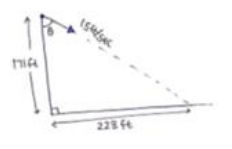Question:
A person standing on top of a cliff $171 \mathrm{ft}$ high has to throw a packet to his friend standing on the ground $228 \mathrm{ft}$ horizontally away. If he throws the packet directly aiming at the friend with a speed of $15.0 \mathrm{ft} / \mathrm{s}$, how short will the packet fall?
Solution:
$\operatorname{Tan} \theta=228 / 171=4 / 3$
$\theta=53^{\circ}$

$x$-axis $y$-axis
$u_{x}=15 \sin 53 u_{y}=15 \cos 53$
$u_{x}=12 \mathrm{ft} / \mathrm{sec} \mathrm{u}_{\mathrm{y}}=9 \mathrm{ft} / \mathrm{sec}$
$a_{y}=32 \mathrm{ft} / \mathrm{sec}^{2}$
$s_{y}=171 \mathrm{ft}$
$s_{y}=u_{y} t+\frac{1}{2} a_{y} t^{2}$
$171=9 t+^{\frac{1}{2}}(32) t^{2}$
$t=3$ sec
$s_{x}=12 \times 3$
$=36 \mathrm{ft}$
Packet will fall short by $=228-36=192 \mathrm{ft}$
